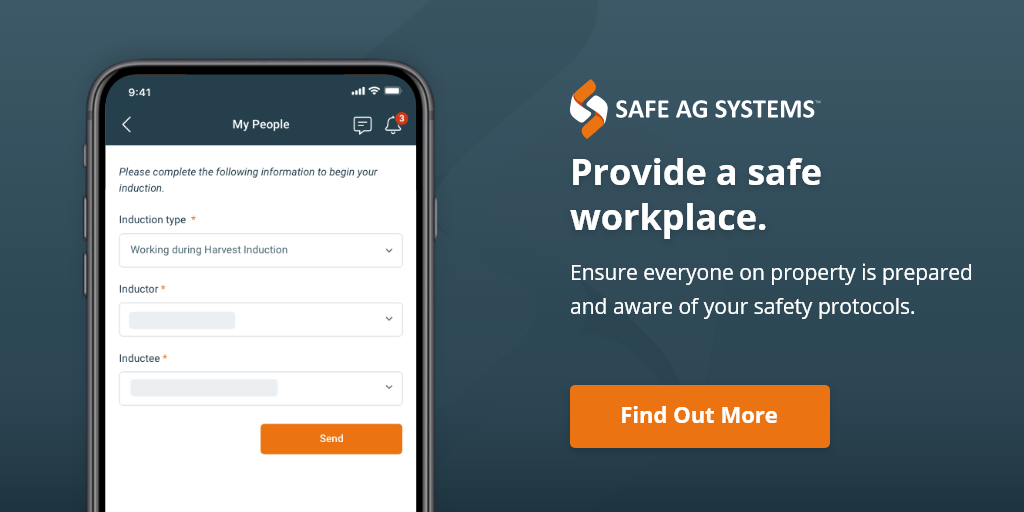Weather in the lead up to summer can be unpredictable and summer itself can be incredibly hot, bringing about extra risks when working outdoors in agriculture.
Two key personal safety issues to consider when outdoors are sun exposure which can lead to skin cancer, and heat exhaustion.
Skin cancer
Did you know that your skin is your largest organ of the body? There are three types of skin cancer that can affect you; Basal cell carcinoma (BCC), Squamous cell carcinoma (SCC) and Melanoma. Over 95% of skin cancers are caused by UV exposure. When unprotected skin is exposed to UV radiation, the structure and behaviour of the cells can change.
Looking at the statistics for skin cancer is frightening - there's no denying it. As the third most common cancer in Australia, melanoma affects more than 13,000 Australians every year. And almost 980,000 new cases of BCC and SCC are treated each year. Australia and New Zealand have the highest rates of melanoma in the world.
Outdoor workers receive up to 10 times more UV radiation exposure than indoor workers, significantly increasing their risk of developing skin cancer, including melanoma.
But there is good news. Survival rates from skin cancer are surprisingly high. The five-year relative survival rate for melanoma is 90% for men and 94% for women and for non-melanoma skin cancer it's 68% for men and 70% for women.
We know the evidence proves that catching skin cancer early can be the difference between life and death.
Here are some tips from Cancer Council NSW on how you can check for skin cancer:
- Become familiar with your skin, take note of any moles or irregularities.
- When checking your skin, make sure you check everywhere, not just the parts that are usually exposed to the sun.
- Look for changes in shape, size and colour or any new spots.
- Ask family or friends for help with difficult to see areas such as your back.
To help you know what's normal and what's not, use the SunSmart ABCD guide when checking your skin:
- A = Asymmetry, look for spots that are asymmetrical (one half of the spot doesn't match the other).
- B = Border, look for spots with uneven borders. Melanoma is often flat with an uneven, smudgy outline .
- C = Colour, look for spots with an unusual or uneven colour. May be blotchy and more than one colour - brown, black, blue, grey or red.
- D = Diameter, look for spots that are larger than 7mm.
Most importantly, if you see anything unusual, book an appointment with your GP.
Heat exhaustion
Just as we know Australian summers can be long and hot, so too do we know that working during this time of year can be exhausting, especially outdoors. However, heat stress is a serious health issue which is more than just feeling hot and uncomfortable while working.
When your body can't cool itself, you absorb more heat from your environment than you can get rid of through sweating or other cooling mechanisms. Factors that contribute to this include the amount of air movement, clothing, humidity, physical activity, radiant temperature of surroundings and general temperature.
Symptoms of heat illness include headache, nausea, dizziness, weakness, irritability, thirst, cramps, heavy sweating, impaired judgement, loss of concentration, clumsiness, collapse, cold and clammy skin.
It is important you don't ignore these signs and if you notice them in your workers, seek immediate medical attention. Young workers are particularly at risk, possibly because of the physically strenuous work they undertake, or from not being accustomed to the conditions.
In November 2017 a 27 year old backpacker died after collapsing from heat stress on a watermelon farm in North Queensland. In October 2020, the employer was fined over $65,000 plus court costs for breaching Queensland's Work Health and Safety Act 2011 as they had failed their health and safety obligations.
Employers have a duty of care to protect both themselves and their workers from the effects of UV radiation as it's a known carcinogen and from the risks of heat exhaustion. Appropriate sun protection measures must be provided in a safe working environment, as well as ongoing education that promotes personal responsibility for skin cancer prevention.
When considering the risks, the Cancer Council has developed a useful risk assessment tool for outdoor work to determine your risk of UV exposure.
Some things to consider to reduce the risk of sun exposure, heat stress and keep you cool include:
- Rescheduling outdoor tasks to early in the morning or late in the afternoon when UV and heat are lower
- Provide rest breaks in cool areas
- Rotate staff so it's not always the same people outside
- Provide portable or natural shading such as trees
- Wear light clothing that provides adequate sun protection
- Make sure new workers acclimatise to the conditions
- Provide protection for your workers such as a broad-brimmed hat, sunglasses, sunscreen and shade cloth, plus ensure there is plenty of cool drinking water available nearby.
Finally, it's an important time to make sure all policies for working in the heat (indoors and out) are up to date and provide your workers with guidance during the warmer months. Keep your cool and keep safe!

Disclaimer: Content on this website may be of relevance to users outside of Australia, but content links and examples are specific to Australia. Please check with your local authority for your country and industry requirements.










